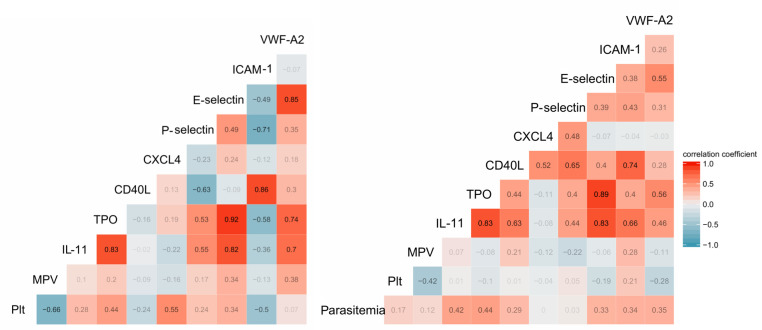Platelet disturbances correlate with endothelial cell activation in uncomplicated Plasmodium vivax malaria.
Platelets drive endothelial cell activation in many diseases. However, if this occurs in Plasmodium vivax malaria is unclear. As platelets have been reported to be activated and to play a role in inflammatory response during malaria, we hypothesized that this would correlate with endothelial alterations during acute illness. We performed platelet flow cytometry of PAC-1 and P-selectin. We measured platelet markers (CXCL4, CD40L, P-selectin, Thrombopoietin, IL-11) and endothelial activation markers (ICAM-1, von Willebrand Factor and E-selectin) in plasma with a multiplex-based assay. The values of each mediator were used to generate heatmaps, K-means clustering and Principal Component analysis. In addition, we determined pair-wise Pearson's correlation coefficients to generate correlation networks. Platelet counts were reduced, and mean platelet volume increased in malaria patients. The activation of circulating platelets in flow cytometry did not differ between patients and controls. CD40L levels (Median [IQ]: 517 [406-651] vs. 1029 [732-1267] pg/mL, P = 0.0001) were significantly higher in patients, while P-selectin and CXCL4 showed a nonsignificant trend towards higher levels in patients. The network correlation approach demonstrated the correlation between markers of platelet and endothelial activation, and the heatmaps revealed a distinct pattern of activation in two subsets of P. vivax patients when compared to controls. Although absolute platelet activation was not strong in uncomplicated vivax malaria, markers of platelet activity and production were correlated with higher endothelial cell activation, especially in a specific subset of patients.
Authors
João Conrado Khouri Dos-Santos; João Luiz Silva-Filho; Carla C Judice; Ana Carolina Andrade Vitor Kayano; Júlio Aliberti; Ricardo Khouri; Diógenes S de Lima; Helder Nakaya; Marcus Vinicius Guimarães Lacerda; Erich Vinicius De Paula; Stefanie Costa Pinto Lopes; Fabio Trindade Maranhão Costa
External link
Publication Year
Publication Journal
Associeted Project
Systems Immunology of Human Diseases
Lista de serviços
-
As antisense RNA gets intronic.As antisense RNA gets intronic.
-
Androgen responsive intronic non-coding RNAs.Androgen responsive intronic non-coding RNAs.
-
Conserved tissue expression signatures of intronic noncoding RNAs transcribed from human and mouse loci.Conserved tissue expression signatures of intronic noncoding RNAs transcribed from human and mouse loci.
-
The intronic long noncoding RNA ANRASSF1 recruits PRC2 to the RASSF1A promoter, reducing the expression of RASSF1A and increasing cell proliferation.The intronic long noncoding RNA ANRASSF1 recruits PRC2 to the RASSF1A promoter, reducing the expression of RASSF1A and increasing cell proliferation.
-
Antisense intronic non-coding RNA levels correlate to the degree of tumor differentiation in prostate cancer.Antisense intronic non-coding RNA levels correlate to the degree of tumor differentiation in prostate cancer.
-
Insight Into the Long Noncoding RNA and mRNA Coexpression Profile in the Human Blood Transcriptome Upon Leishmania infantum Infection.Insight Into the Long Noncoding RNA and mRNA Coexpression Profile in the Human Blood Transcriptome Upon Leishmania infantum Infection.
-
Long non-coding RNAs associated with infection and vaccine-induced immunityLong non-coding RNAs associated with infection and vaccine-induced immunity
-
Comparative transcriptomic analysis of long noncoding RNAs in Leishmania-infected human macrophagesComparative transcriptomic analysis of long noncoding RNAs in Leishmania-infected human macrophages
-
SARS-CoV-2 Selectively Induces the Expression of Unproductive Splicing Isoforms of Interferon, Class I MHC, and Splicing Machinery Genes.SARS-CoV-2 Selectively Induces the Expression of Unproductive Splicing Isoforms of Interferon, Class I MHC, and Splicing Machinery Genes.

